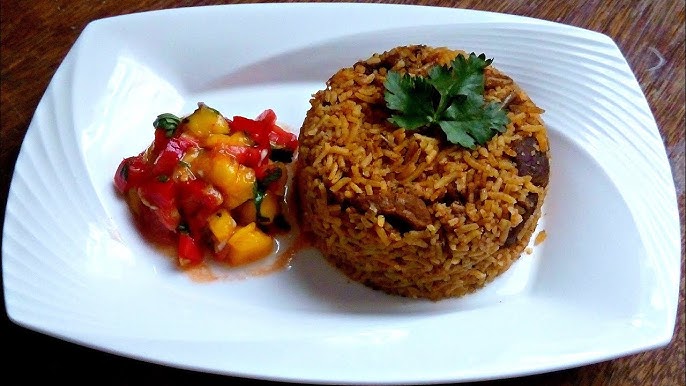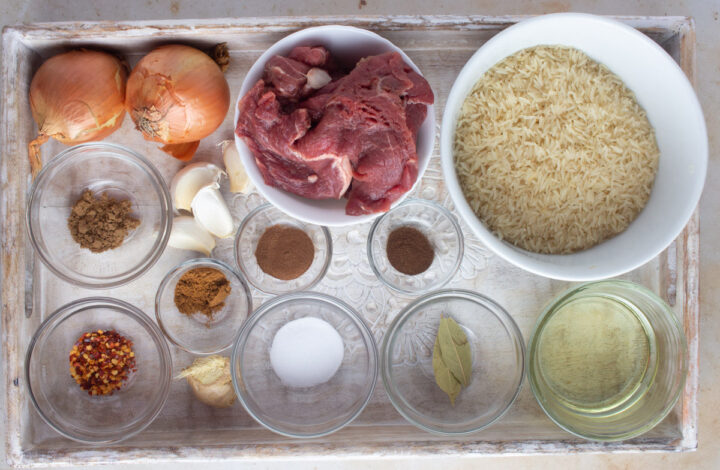
East African cuisine is a vibrant tapestry of diverse flavors and culinary traditions, and one dish that stands out as a symbol of this rich culinary heritage is the famous Kenyan Pilau.
The term “pilau” might sound exotic, but at its core, it’s a flavorful, spiced rice dish that’s accessible to anyone willing to explore its delightful world. Today, we’ll take a deep note into Kenyan Pilau, breaking down its history, ingredients, preparation, and the cultural significance it holds.

The Origins of Kenyan Pilau
Pilau, a beloved dish in Kenya, has a fascinating history that reflects the country’s cultural diversity and the influence of the Indian Ocean trade routes. We have also written How To Prepare Egusi stew For Rice..
The dish’s name itself is derived from the Persian word “pilav,” which was brought to East Africa by traders, immigrants, and settlers from the Arabian Peninsula and the Indian subcontinent.
Over time, Kenyan Pilau evolved, incorporating local ingredients and culinary techniques, creating a unique and unmistakable East African flavor.

The Essential Ingredients For East African Pilau – Kenyan pilau
- Rice
- Meat or vegetables
- Spices
- onions, Ginger and garlic
- Tomatoes
- Ghee or oil
- Stock or water
Kenyan Pilau is renowned for its aromatic spices and savory goodness. Let’s take a closer look at the key ingredients that come together to create this mouthwatering dish:
- Rice: The heart of any pilau is the rice. In Kenya, Basmati rice is the preferred choice, thanks to its long grains that remain separate and fluffy when cooked.
- Meat or Vegetables: While meat options like chicken, beef, and goat are popular choices, vegetarians can enjoy pilau made with vegetables like potatoes, peas, and carrots. The meat or vegetables are usually browned to add depth to the flavor.
- Spices: The aromatic spices in Kenyan Pilau are what make it truly special. Common spices include cumin, cardamom, cloves, cinnamon, and bay leaves. These spices infuse the dish with a warm, exotic fragrance and rich flavor.
- Onions, Garlic and Ginger: These aromatics serve as the base for building the flavor profile of the dish. They are often sautéed in oil or ghee until golden brown.
- Tomatoes: Tomatoes contribute a touch of acidity and color to the pilau. They’re often added in the form of tomato paste or freshly chopped tomatoes.
- Ghee or Oil: Ghee, a clarified butter, is traditionally used for pilau, but you can also use cooking oil for a lighter version.
- Stock or Water: To cook the rice and create a flavorful base, you’ll need either chicken or vegetable stock. If stock is not available, water can be used as an alternative.
East African Pilau – Kenyan pilau Cooking Process
Now that we’ve gathered our ingredients, let’s dive into the step-by-step process of making Kenyan Pilau: Read also: How To Cook Ofada Rice And Stew| Easy Guide
How to make pilau rice
- Preparation: Start by washing the rice thoroughly and soaking it in cold water for 30 minutes. This removes excess starch, ensuring the rice grains remain separate when cooked. Meanwhile, prepare your meat or vegetables by cutting them into bite-sized pieces.
- Sauté the Aromatics: In a large pan, heat ghee or oil over medium heat. Add finely chopped onions and minced garlic and ginger, and sauté until they turn a rich, golden brown.
- Spice It Up: Add your aromatic spices – cumin, cardamom, cloves, cinnamon, and bay leaves. Toast the spices for a minute or two to release their flavors, creating a heavenly aroma.
- Meat or Vegetables: If you’re preparing a meat-based pilau, add the meat pieces at this stage and brown them. For a vegetarian version, you can proceed to the next step.
- Tomatoes: Incorporate your tomatoes. You can either add tomato paste or fresh tomatoes. Cook until they break down and blend into the mixture.

- Rice and Stock: Drain the soaked rice and add it to the pan. Stir to combine it with the spices, onions, and tomatoes. Now, add your stock (or water) and bring the mixture to a boil.
Recommended: Ingredients For Cooking One bag of Rice) And How To Get The Cooking Right.
- Simmer and Cover: Reduce the heat to low, cover the pan, and let the pilau simmer. The rice will absorb the liquid and become tender. This process can take anywhere from 15 to 30 minutes, depending on the type of rice you’re using.
- Final Touch: Just before the rice is fully cooked, give the pilau one last stir. At this point, you can add the vegetables if you’re making a vegetarian version.
- Rest and Serve: Once the rice is tender and has absorbed all the flavorful liquid, remove the pan from the heat. Allow it to rest for a few minutes before serving. The resting period allows the flavors to meld and the rice to fluff up perfectly.

The Cultural Significance of Kenyan Pilau
Kenyan Pilau is not just a dish; it’s a cultural symbol that reflects the country’s diverse heritage. It is an integral part of Kenyan celebrations, from weddings and family gatherings to religious festivals and holidays. Pilau brings people together, and the act of making and sharing it carries immense cultural significance.
In Kenyan culture, pilau is often associated with communal dining. It’s not unusual to see large gatherings where a massive pot of pilau is prepared to feed a crowd.
This tradition fosters a sense of togetherness and unity, reflecting the warm and welcoming nature of Kenyan people.
Furthermore, the spice blend used in Kenyan Pilau is a testament to the influence of Indian, Arabian, and Swahili cuisines in the region.
It showcases the harmonious blending of different culinary traditions, making it a true representation of East African culture.
Read also: The Best Nigerian Jollof Rice & Beans Combo
Enjoying Kenyan Pilau
Now that you’ve learned about the history, ingredients, and preparation of Kenyan Pilau, it’s time to savor this flavorful dish. When serving pilau, it’s common to garnish it with fried onions, chopped cilantro, and a squeeze of fresh lemon juice for that extra burst of flavor.
Pair your pilau with accompaniments like kachumbari (a fresh tomato and onion salad), raita (yogurt with spices and herbs), or a spicy chutney to elevate your meal even further.
Don’t forget to prepare a cup of spiced chai or refreshing fresh juice to complete the experience.
Read also: Easy Guide On How To Make Carrot Cauliflower Rice And Salad with Avocado Cream Dressing.
Pilau Hawaiian is a delightful fusion dish that combines the aromatic flavors of traditional Kenyan pilau with a tropical twist, incorporating ingredients like pineapple and coconut for a unique and delicious experience.
Pilau Hawaiian refers to a culinary fusion that marries traditional Kenyan pilau with Hawaiian flavors. This delightful dish often incorporates tropical ingredients like pineapple and coconut, resulting in a unique and flavorful combination of East African and Pacific Island cuisines.
The brown color of pilau primarily comes from the caramelization of onions and the spices used in the dish. These ingredients are sautéed until they turn golden brown, imparting a rich color to the rice.
In Conclusion
Kenyan Pilau is a true culinary gem that offers a delightful taste of East African culture. With its aromatic spices, rich history, and cultural significance, it’s a dish that not only pleases the palate but also serves as a window into the diverse and vibrant traditions of Kenya.
So, the next time you’re looking for a culinary adventure, give Kenyan Pilau a try.
It’s a dish that will transport your taste buds to the heart of East Africa, offering a rich and flavorful experience that’s sure to leave a lasting impression.
